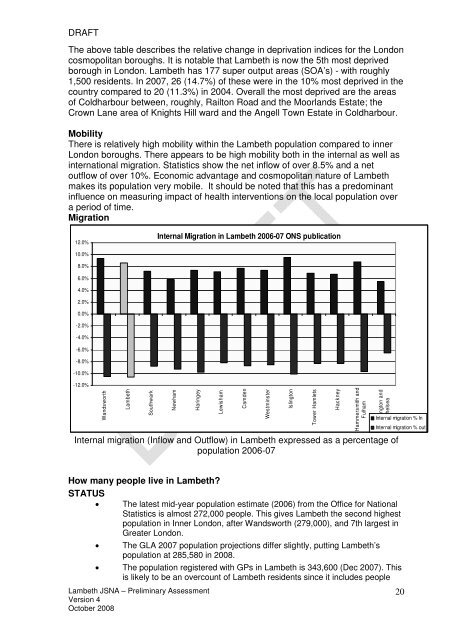04a JSNA Appendix , item 5. PDF 6 MB - Lambeth Council
04a JSNA Appendix , item 5. PDF 6 MB - Lambeth Council
04a JSNA Appendix , item 5. PDF 6 MB - Lambeth Council
You also want an ePaper? Increase the reach of your titles
YUMPU automatically turns print PDFs into web optimized ePapers that Google loves.
DRAFT<br />
The above table describes the relative change in deprivation indices for the London<br />
cosmopolitan boroughs. It is notable that <strong>Lambeth</strong> is now the 5th most deprived<br />
borough in London. <strong>Lambeth</strong> has 177 super output areas (SOA’s) - with roughly<br />
1,500 residents. In 2007, 26 (14.7%) of these were in the 10% most deprived in the<br />
country compared to 20 (11.3%) in 2004. Overall the most deprived are the areas<br />
of Coldharbour between, roughly, Railton Road and the Moorlands Estate; the<br />
Crown Lane area of Knights Hill ward and the Angell Town Estate in Coldharbour.<br />
Mobility<br />
There is relatively high mobility within the <strong>Lambeth</strong> population compared to inner<br />
London boroughs. There appears to be high mobility both in the internal as well as<br />
international migration. Statistics show the net inflow of over 8.5% and a net<br />
outflow of over 10%. Economic advantage and cosmopolitan nature of <strong>Lambeth</strong><br />
makes its population very mobile. It should be noted that this has a predominant<br />
influence on measuring impact of health interventions on the local population over<br />
a period of time.<br />
Migration<br />
12.0%<br />
Internal Migration in <strong>Lambeth</strong> 2006-07 ONS publication<br />
10.0%<br />
8.0%<br />
6.0%<br />
4.0%<br />
2.0%<br />
0.0%<br />
-2.0%<br />
-4.0%<br />
-6.0%<br />
-8.0%<br />
-10.0%<br />
-12.0%<br />
Wandsworth<br />
<strong>Lambeth</strong><br />
Southwark<br />
Newham<br />
Haringey<br />
Lewisham<br />
Internal migration (Inflow and Outflow) in <strong>Lambeth</strong> expressed as a percentage of<br />
population 2006-07<br />
Camden<br />
Westminster<br />
Islington<br />
Tower Hamlets<br />
Hackney<br />
Hammersmith and<br />
Fulham<br />
Kensington and<br />
Chelsea<br />
Internal migration % In<br />
Internal migration % out<br />
How many people live in <strong>Lambeth</strong>?<br />
STATUS<br />
• The latest mid-year population estimate (2006) from the Office for National<br />
Statistics is almost 272,000 people. This gives <strong>Lambeth</strong> the second highest<br />
population in Inner London, after Wandsworth (279,000), and 7th largest in<br />
Greater London.<br />
• The GLA 2007 population projections differ slightly, putting <strong>Lambeth</strong>’s<br />
population at 285,580 in 2008.<br />
• The population registered with GPs in <strong>Lambeth</strong> is 343,600 (Dec 2007). This<br />
is likely to be an overcount of <strong>Lambeth</strong> residents since it includes people<br />
<strong>Lambeth</strong> <strong>JSNA</strong> – Preliminary Assessment<br />
Version 4<br />
October 2008<br />
20
















